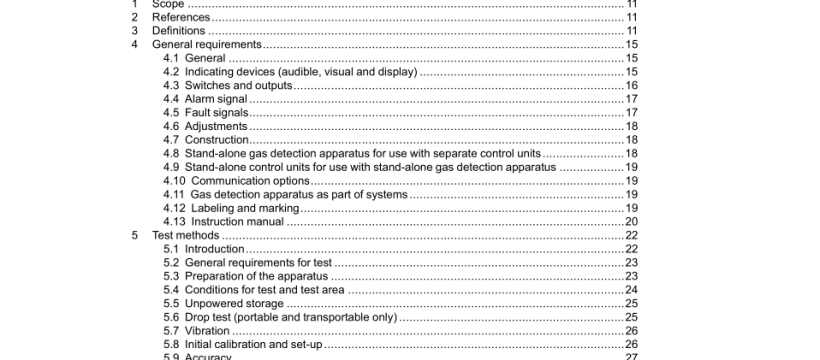UL 920001-2021 pdf download.Performance Requirements for Toxic
Gas Detectors.
2 References ANSI/ISA-12.13.01, Performance Requirements for Combustible Gas Detectors ISA-RP92.0.02, Installation, Operation, and Maintenance of Toxic Gas-Detection Instruments: Hydrogen Sulfide (recommended practice for this standard), establishes user criteria for the installation, operation, and maintenance of toxic gas-detection instruments ANSI/ISA-92.04.01, Performance Requirements for Instruments Used to Detect Oxygen- Deficient/Oxygen-Enriched Atmospheres National Institute for Occupational Safety and Health (NIOSH) Pocket Guide to Chemical Hazards, Title 29, Part 1910.1000, Occupational Safety and Health Standards Threshold Limit Values for Chemical Substances in the Work Environment Adopted by the American Conference of Governmental Industrial Hygienists (ACGIH) Documentation for Immediately Dangerous to Life or Health Concentrations (IDLHs) (NIOSH Taft Laboratories) EN 50270, Electromagnetic Compatibility – Electrical Apparatus for the Detection and Measurement of Combustible Gases, Toxic Gases or Oxygen 3 Definitions For the purposes of this standard, the following definitions apply: 3.1 alarm: an audible, visual, or physical signal that alerts the instrument user of a dangerous gas concentration or instrument problem
3.15 gas-detection apparatus: an assembly of electrical and mechanical components (either a single integrated unit or a system comprised of two or more physically separate but interconnected component parts) which senses the presence of a gas and responds by providing an alarm, indication, or other output functions. 3.16 gas-sensing element: the particular subassembly or element in the gas-detection apparatus that, in the presence of a gas, produces a change in its electrical, chemical, or physical characteristics. 3.17 indication: a discrete communication of a measured value or alarm condition. 3.18 IDLH (Immediately Dangerous to Life and Health): the maximum concentration from which, in the event of respirator failure, one could escape within 30 minutes without a respirator and without experiencing any escape-impairing (e.g., severe eye irritation) or irreversible health effects. 3.19 mobile apparatus: a continuous-monitoring apparatus mounted on a vehicle, such as, but not limited to, a mining machine or industrial truck. 3.20 nominal voltage: the voltage given by manufacturers as the recommended operating voltage of their gas detection equipment. If a range (versus a specific voltage) is given, the nominal voltage shall be considered as the midpoint of the range, unless otherwise specified. 3.21 PEL (Permissible Exposure Limit): time-weighted average (TWA) concentration that must not be exceeded during any 8-hour work shift of a 40-hour work week, as defined by the Occupational Safety and Health Administration (OSHA).
3.25 spot-reading apparatus: apparatus intended to be used for short periods of time as required (typically 5 min or less). 3.26 sample-draw: a method to cause deliberate flow of the atmosphere being monitored to a gas-sensing element. 3.27 signal-processing detector head: an apparatus intended to be incorporated with separate signal processing, data acquisition, central monitoring, or other similar systems in which the apparatus provides a conditioned electronic signal or output indication to systems of the aforementioned type that typically process information from various locations and sources including, but not limited to, gas-detection apparatus. 3.28 span: the algebraic difference between the upper and lower values of a range. 3.29 stabilization: state when three successive readings of an apparatus, taken at intervals equal to the maximum t(90) value defined in Annex A (Item 5), indicates no changes greater than the accuracy value defined in Annex A (Item 2). 3.30 stationary apparatus: a gas-detection apparatus intended for permanent installation in a fixed location. 3.31 (TLV-)STEL, (Threshold Limit Value-) Short-Term Exposure Limit: a 15-minute Time-Weighted Average (TWA) exposure that should not be exceeded at any time during a workday, even if the 8-hour TWA is within the Threshold Limit Value – Time-Weighted Average (TLV-TWA). 3.32 test gas: toxic gas diluted with clean air or inert gas to a known concentration within the test-gas tolerance stated in Annex A, Item 1. 3.33 transportable apparatus: apparatus not intended to be portable, but which can be moved readily from one place to another.UL 920001-2021 pdf download.
UL 920001-2021 pdf download
